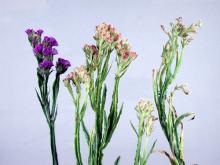Cause Turnip mosaic virus has been reported from California for the perennial Limonium perezii. This disease has been sap- and aphid-transmitted to L. sinuatum. The disease spread rapidly, producing irregular patterns in the field. Several other viruses in Europe on the annual L. sinuatum include broad bean wilt virus, cucumber mosaic virus, statice Y virus, tobacco rattle virus, and tomato bushy stunt virus. Carnation mottle virus and clover yellow vein virus also are listed, but descriptions and distribution are unknown. Also, note that the aster yellows phytoplasma (Candidatus Phytoplasma asteris) can infect this host. Occurrence of these problems in the Pacific Northwest is unknown.
Symptoms Turnip mosaic virus-mosaic, stunting, and premature death of infected plants.
BBWV-stunted plants with small, puckered, twisted, wilted, deformed leaves. Sometimes a mosaic pattern.
CMV-mosaic pattern on leaves sometimes combined with distortion, red leaves, and reduced growth.
Statice Y -light green mosaic, stunting, and narrow or deformed leaves.
TRV-bright yellow or red line patterns and ringspots on leaves.
TBSV-premature reddening of leaves, reduced yield, and small flower stalks.
Cultural control None have been tested, but the following may help.
- Plant pathogen-free stock or seed from pathogen-free stock.
- Minimize field operations to reduce mechanical transmission.
References Engelhard, A.W. 1985. Statice (Limonium spp.). In: Strider, D.L. (ed). Diseases of Floral Crops, vol. 2. New York: Praeger Publishers.
Niblett, C.L., Paulus, A.O., and Semancik, J.S. 1969. A mosaic disease of statice caused by turnip mosaic virus. Phytopathology 59:1166-1167.


